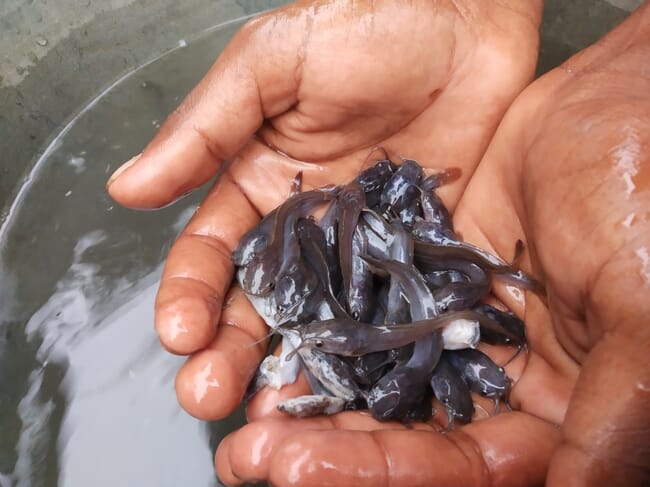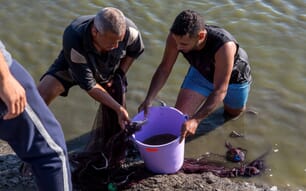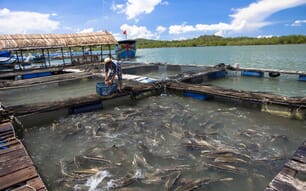1. They weren’t there in the first place
Either the number of fingerlings was a lot less than what it was supposed to be or the fish looked like fingerlings but were really tadpoles. Some tadpoles have barbles (whiskers), just like catfish do. So the farmer thinks they are feeding catfish when they are really feeding tadpoles, which eventually grow feet and hop away. If the fish transporter arrives at night and insists on dumping the fish directly into the pond, be suspicious. Government-funded programmes that supply fingerlings for “free” tend to short the famers on number and on quality.
2. Very poor health of fish at stocking
This is because the fry or fingerlings were not properly conditioned prior to transport (perhaps taken directly from a pond and transported) or were in poor health to begin with, or were stressed during transport due to lack of oxygen or poor water quality. They will usually die within about four days, but the farmer is not likely to see them dead; they do not always float after dying and even if they do, birds may pick them up in the early hours of the morning before the farmer gets to the pond.

3. Very poor acclimation of the fish
A big difference in temperature between the transport water and the receiving water will cause death in the days following stocking. Also, a big difference in pH and/or alkalinity has been known to lead to death after stocking. As well, in some cases, with certain transport containers, oxygen can build up to very excessive super-saturation and cause death after stocking. So even if fish were well conditioned and in good health and transported correctly, they can still be doomed if the acclimation was not done correctly.
4. The pond or cage was stocked correctly, but the fish still disappeared
This could happen if the fish left the pond via the inlet. Almost all fish tend to swim against the current. When water is added to the pond, the fish often are seen to accumulate near the inlet, because there is maybe more oxygen there but also because the fish are trying to swim upstream. If the inlet is an open channel with no screen, the fish will swim out. They can jump pretty far.
However, they often will not do this when you are watching- they wait until you leave. Pond inlets should be screened, and the best way to screen is with a “filter sock” because that gives a larger screen area than a piece of screen tied on a pipe or a screen in a channel. Even the clarias walking catfish tends to leave via the inlet as opposed to just walking away out of a pond. We have had market-size clarias in small ponds with only 10 cm freeboard and did not lose any fish because the inlet was protected with a filter sock. This means that if you make a fence around your catfish pond and do not protect the inlet, you are not doing much good. There are some cases in which a pond overflows and washes many of the fish away; usually because the outlet or overflow was screened improperly or blocked.
5. Predators
These often get blamed when the real reason was something like situations 1 through 4 above.
However, some predators can really clean out a pond. For catfish, the problem is that when feed quality is low, the fish tend to look for other sources of protein in the pond and often find other catfish to fill their dietary needs. As well, if the pond is not completely dried out some catfish or other predator fish can remain and will consume the newly stocked fish in the next cycle.
There is a discussion on predators and what to do about them in this catfish manual. For very small fry, insect and frog predators are indeed problematic. These are all management issues.
6. Water quality
Low dissolved oxygen is the usual culprit for tilapia or for very small catfish. However, the fish will go off feed as the water quality degrades. Adding more feed will only make the situation worse. When all or almost all fish die at once, water quality is the most likely cause. It can be low oxygen, high nitrites, high ammonia, hydrogen sulfide, a toxin , released by the algae, or a toxin that was added to the pond on purpose or by accident. This will not go unnoticed-you will see this if you visit the pond daily.
7. Disease
Fish tend to begin dying at a few per day then the rate picks up. Before the disease hits, there is often a water quality problem that perhaps doesn’t kill the fish but makes them susceptible to disease. Some moulds on feed will cause vitamin deficiencies that will become noticeable over time and may look like disease. In most of these instances, the farmer should notice fish in poor health or dead fish. A corollary to this is excessive handling that occurs as a result of sampling; especially in research projects where the researchers think they have to individually measure all the fish in a sample once or twice a month.
8. Theft
Some books include this in the predator section. Theft can be chronic, like workers removing a few fish every day, or catastrophic, when thieves come and drain a pond or slash a cage. I have been on stations where we’ve had to lock down the holding tanks so the “watchmen” wouldn’t steal the fish.
The big problem comes when the farmers have been feeding imaginary fish for several months and then they are surprised at harvest. If the feeding was done properly, this should never happen because the response to the feed is based upon the fish biomass in the pond. However, with sinking feed, it is extremely tricky to gauge response.
Unless the fish went missing the day prior to harvest (suspect theft from the farm workers in this case), the farmer should notice that the fish are not consuming the amounts they should at that size and number. This is much easier with floating feed but people still make mistakes and overfeed. If it takes more than 10 -15 minutes for the fish to consume the feed, you are overfeeding.
We often say “kill your fish early”- which means that in the event you are going to lose fish, it is better to lose them before you have too much invested in them. Of course nobody wants to lose fish. A one month nursery phase is a pretty good idea for farmers who have trouble figuring out if their fish are all there. The fingerlings should be put into a small pond that can be closely watched and protected. Feeding will be easier as well.
After one or two months, they can then be inventoried and transferred to the grow-out pond. Care must be take to assure correct handling, otherwise you cause situation two or three above. At this point, they can be re-counted and total weight measured. The fish will be a bit more resistant to handling compared to when they were very small. Then the feeding rate can be recalculated so you can avoid overfeeding.
For farmers who have had these problems, I think you know by now that fish farming may be simple but it is not easy, it requires daily oversight. If you cannot assure daily oversight, do not buy expensive feed, in fact, don’t buy anything; because you will likely not get anything back.


